By Gary Reisenwitz
There is continual controversy among the sub-gun competitors as to the merits and virtues of the 9mm /M16 submachine gun. Most of the arguments and comparisons are based upon an evaluation of an unmodified factory original Colt 9mm/M16. However, the shooters and collectors out there know that for every “original spec” Colt M16/9mm in public ownership, there are probably 50 clones in various non-standard configurations. Let’s look at how this “system” can be modified to effect a caliber conversion, while optimizing the particular characteristics that might be most useful to the shooter/collector.
Most of the 9mm /M16 sub-guns out there are not in an original Colt configuration. Many are using after market registered lower receivers or registered sears and use an after market conversion. The shooting community has two basic systems to choose from with regard to converting the M16 from 5.56mm caliber to 9mm caliber. These are the SGW style conversions and the Colt style conversions. There are advantages and disadvantages to each, and the purpose of this article is to describe these systems, and offer a comparative analysis. In addition to the basic caliber conversion systems, there are other means of customizing the converted weapons, to make them better suited to the needs and requirements of the individual shooter/collector, and a few of these will be covered as well.
The SGW style system has been around for many years, and has an extensive following among the shooting community. The system consists of a dedicated upper receiver/barrel assembly, a dedicated special bolt and carrier assembly and either a magazine well insert (for use with modified STEN magazines and special magazine catch) or a specially modified STEN magazine that will fit into an unmodified M16 magazine well (and use the standard M16 magazine catch.)
The Colt style system is typically assembled with an M16 type upper receiver (no forward assist), Colt or after market barrel, a variety of handguard configurations, a Colt full-auto bolt assembly, a special heavy buffer, a pair of magazine well inserts, a special Colt bolt catch (optional), and either an original Colt magazine, or a modified UZI magazine.
The primary advantages of the SGW conversions are that they are much less expensive to assemble, use relatively inexpensive modified STEN magazines, and have been commercially available for a much longer period of time. The magazine well adapter for the SGW conversion is easily installed and results in no permanent modification to the lower receiver. Some weak points to the SGW conversion are that the magazine release system may be altered, the ejector is somewhat less reliable, and changing the barrel configuration is more difficult.
The SGW style conversion uses an unusual ejector system to eject spent cartridges during firing. The ejector consists of a coil spring extension mounted on a cross pin within the upper receiver. Some users have complained about these ejector springs breaking, while others have used them for years with great success. There are some variances in their reliability. The SGW conversion also retains a fully functional forward assist mechanism, as is found on the M16A1 and A2 5.56mm rifles. The SGW systems are available as complete upper receiver/barrel units from the factory, complete with the magazine well adapters and proprietary magazines. The SGW uppers are only available to the general public, to include class 3 dealers, in semi-automatic form, which means 16 inch barrels and semi-auto bolt carriers. Olympic Arms, Inc. (SGW) could not sell class 3 configuration parts to anyone but police departments due to onerous state laws. Therefore, if you purchase an SGW 9mm conversion directly from them, you’ll have to convert it to select fire configuration if you wish to use it in a machine gun. This would require the installation of the sear trip step on the underside of the bolt carrier, and possibly shortening the barrel. However, Dalphon, Inc. offers the SGW style conversion in complete full-auto configuration, and offers short barrels with threaded muzzles, etc.
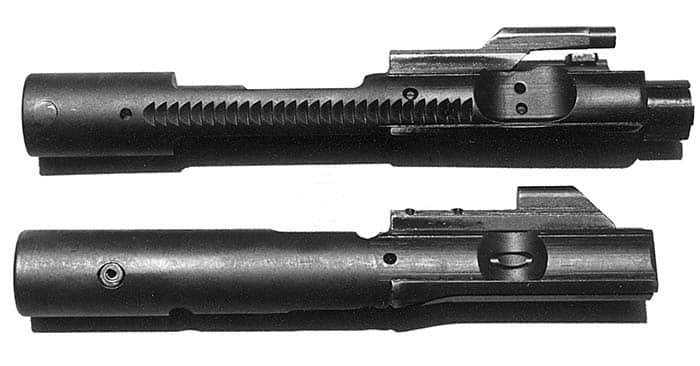
The magazine well adapters that Olympic Arms (SGW) uses are retained by the standard M16 magazine catch. They work very well with the modified STEN magazines. Dalphon, Inc. also sells magazines that work with the SGW conversion kit that require no magazine well adapters. The advantage of using magazines that have the adapters attached to them, is that the shooter does not have to re-learn where the magazine catch is to change magazines. Another advantage is that the shooter would not be able to inadvertently eject the magazine well adapter during a rapid and possibly stressful magazine change, by hitting the wrong catch. The only disadvantages to the magazines that have the adapters attached, are that they may no longer fit in the typical magazine pouches because they are too wide at the top. Custom magazine pouches could be made, but magazine changing would still be a little more awkward than with standard unmodified magazines. SGW did make a 25 round plastic magazine that resembles a straight 30 round 5.56mm M16 magazine, but held 25 9mm cartridges. This magazine would fit in any magazine pouch that works with the standard 5.56mm M16 magazine, and did not require an additional magazine well adapter. It worked with the standard M16 magazine catch. The current status of these plastic magazines, and their availability, is unknown.
The Colt style system is very different. The Colt style system has evolved from the original Colt 9mm/M16 machine-guns and carbines that were designed for the military and law enforcement markets. Colt has always been very hesitant to sell repair parts for these weapons to the public, and still refuses to sell some of the previously critical components. The chief advantage to the Colt system is superiority in design. It is inherently reliable and very simple. The chief disadvantage used to be availability. Fortunately, this has now been alleviated by the after market. C&S Metall-Werkes, in St. Charles, Missouri, now sells a complete Colt style kit that features all the components needed to complete the Colt style conversion on a registered machine gun receiver. The only disadvantage to the C&S kit is that it offers no flexibility regarding upper receiver type, handguard type or barrel configuration.
J&T Surplus offers original Colt 9mm parts for those who wish to purchase original equipment and install it. These kits use the Colt 9mm magazines. J&T has the original Colt magwell blocks available and also offers the Norrel style mag well blocks which install with an allen wrench, no drilling involved.
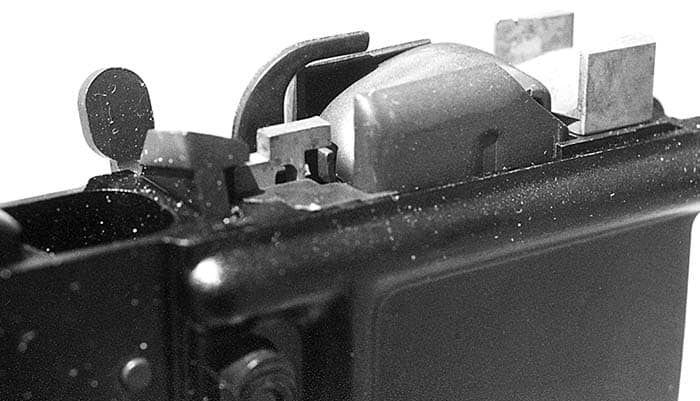
The Colt style system uses a pair of special magazine well adapters that, in the factory guns, are roll pinned into the lower receiver. Colt does not sell these magazine well inserts as repair parts. However, JRW Sports, Inc. now manufactures a set of “drop-in” magazine well inserts that enable the Colt system to be used. These new magazine inserts are very similar to the original Colt inserts, except that they are retained by set screws bearing on the inside of the magazine well, and they now have a sliding bolt catch actuator built into the rear mount that will enable the original Colt magazines to activate the 5.56mm bolt catch, when the magazine runs empty. Therefore, the use of the JRW magazine well inserts will enable the automatic bolt catch feature to work, without having to use the Colt 9mm special bolt catch. The Colt style system also uses a unique bolt and barrel. The 9mm Colt bolt resembles an M16 5.56mm bolt carrier that has had the front end filled in and the carrier key shortened. The Colt style barrels are very similar in external profile to the 5.56mm barrels. They differ significantly in the location of the chamber because the 9mm bolt is shorter than the 5.56mm bolt/carrier assembly, the chamber on the 9mm Colt barrels is closer to the rear of the gun than the chambers found on the 5.56mm guns. The magazine that the Colt system employs resembles an UZI magazine, except that it has a standing rib at the rear, that permits the clearance for a tab on the magazine follower that activates a longer bolt catch. The use of the Colt 9mm bolt catch and the original Colt magazines will cause the gun to retain the bolt to the rear after a magazine has run dry. But, if the 9mm Colt magazine blocks are removed, the longer tab on the 9mm bolt catch will interfere with a 5.56mm magazine, preventing it from properly functioning with a 5.56mm top half. Since the bolt catch is rather difficult to remove and change over, the JRW, Inc. 9mm magazine well inserts are much better suited for use in a convertible weapon. UZI magazines can usually be modified to work in Colt style conversions, but the original Colt magazines are not that expensive and are currently readily available. The use of a modified UZI magazine will not operate the automatic bolt hold-open feature, regardless of the type of bolt catch , or magazine well inserts that are used . The bolt catch can still be manually activated.
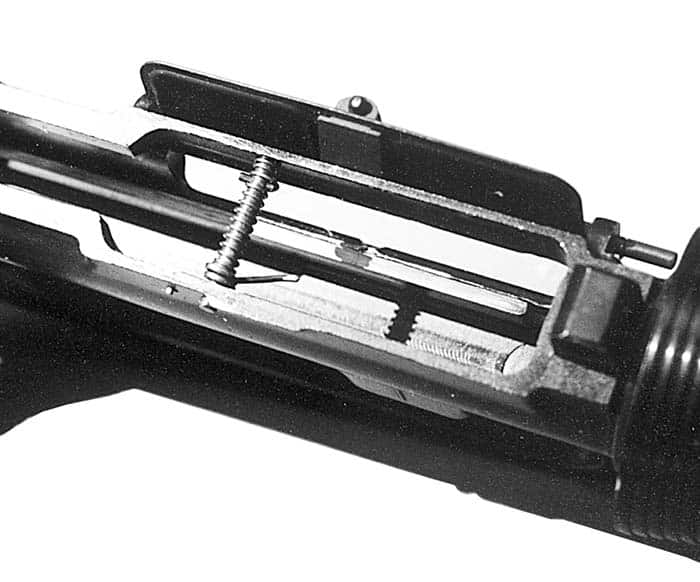
The original Colt 9mm machine-guns and carbines use a special 9mm recoil buffer in the collapsible stock weapons. This buffer is made of steel with a nylon tip and is significantly heavier than the 5.56mm carbine buffer. It is needed to keep the cyclic rate down to a reasonable level (700-750 rpm). Any heavy buffer of about the same weight will work as well. With a full length stock, a full length 5.56mm M16 buffer will work.
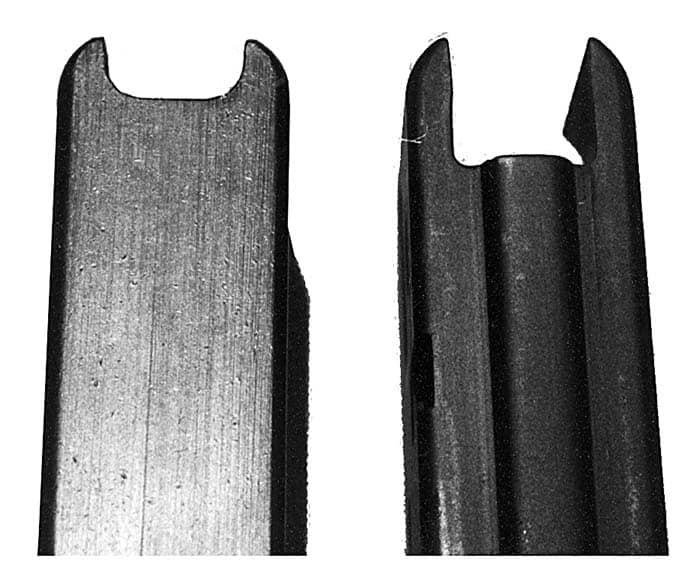
The upper receivers used in the Colt style system are many and varied. Basically, any 5.56mm upper receiver will work. No modification is required to make a functional conversion. The original Colt 9mm/M16 upper receivers strongly resemble the 5.56mm/M16 uppers (before the forward assist feature was added), but there is another small difference. The original Colt 9mm upper receivers use a slightly taller rear leaf sight and the recess, into which it can be folded, is longer than on the 5.56mm uppers. The difference is small, but noticeable if two are held side by side for comparison. Many of the recreational shooters are using flat-top upper receivers making it an unimportant consideration.
There are a few other cosmetic differences between the conversions, but they do not affect function to any reasonable degree. Both of these systems are available as a fully assembled and operational kit from the vendors listed at the end of this article. The Colt style barrels are relatively easy to make (as barrels go) and a drawing is provided to show the critical dimensions for interfacing with the M16 type upper receiver and Colt 9mm bolt.
Mixing and matching conversion parts between the Colt style and SGW systems does not work. The SGW bolt extends forward of the bolt carrier, requiring the chamber of the barrel to be closer to the muzzle than that on the Colt style system. The feed ramp for the SGW system is built into the barrel extension, and on the Colt style system, is attached to the front magazine well insert. This significant difference makes it impossible to use the SGW bolt with the Colt style barrel and vice-versa. Likewise, the magazines that work for one conversion system, will not work in the other.
Regardless of which system of conversion is used, the following additional customization features can be employed to further improve the gun for a particular shooter.
BUTTSTOCK MODIFICATIONS
Changing the buttstock from the collapsible to the full length fixed stock will greatly increase the handling characteristics of the gun. The collapsible stock is just too short for most people, and the total weapon weight is too far forward for good balance. Just changing the stock will make the weapon much more controllable and easier to shoot. You also won’t have to worry about the collapsible stock failing during a match. Remember that the M16A2 stock is 5/8 inch longer than the M16 or M16A1 stock, should optimizing length be important.
BUFFER MODIFICATIONS
There are several options with regard to the buffers that can be used with a 9mm conversion kit. (None of the “drop-in” kits include a buffer!) If the full length stock is used, the regular 5.56mm rifle buffer can be used, or the full length hydraulic buffer, or a new “rate-reducer” buffer, produced by Advanced Armament Corporation. If the short, collapsible buttstock is desired, the original Colt 9mm buffer can be used, the short hydraulic buffer or the short “rate-reducer” buffer are all options. The short 5.56mm CAR buffer is just too light to work well in a 9mm conversion kit.
If the full length stock is to be used, using a full length hydraulic buffer is an expensive option, but may be well worth it in terms of increased controllability, regardless of which type, or style, of 9mm conversion kit is used. The cyclic rate can drop below 600 RPM , and you won’t feel the sharp slapping of the bolt carrier as it bottoms out in the buffer tube. If you haven’t tried this mod, make an effort to test fire a gun with the hydraulic buffer before you discount the price of the buffer. Considering what some people pay for muzzle brakes, this buffer is actually worth the $200 it costs.
The standard rifle buffer will function in the full length stock, but will result in a much higher rate of fire, and a reduction in controllability. But if you are doing this a piece at a time, it will work.
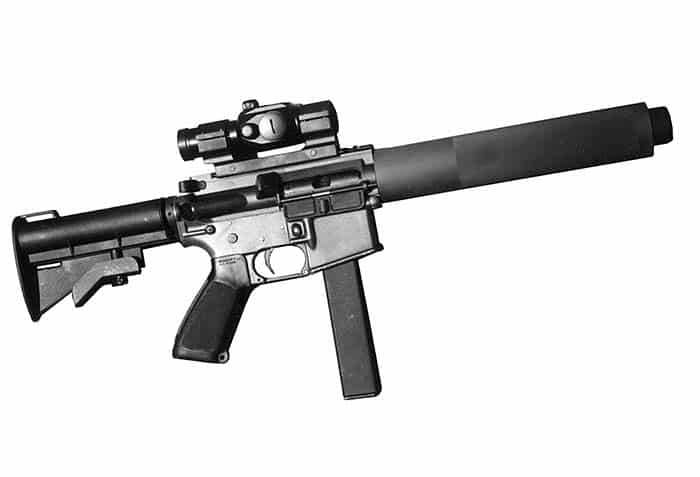
For the collapsible stock, the original Colt 9mm buffer can be used. (The Colt 9mm machine gun buffer is the same as the 9mm Colt semi-automatic carbine buffer.) There are some short hydraulic buffers out there. They differ among each other in mechanical design, and vary between $150 and $300 in price. They are currently harder to get than the full length versions, and are supposed to be optimized for either 9mm or 5.56mm use. They may be interchangeable between calibers, but much about them is unknown.
A new buffer system is now available that may replace the hydraulic buffers as rate reducers. This new system is produced by Advanced Armament Corp. in Lawrenceville, Georgia. They make a series of buffer/spring combos that can be used in either short or full length stocks. The greatest effect is obtained when the full length stock version is used, but there is a carbine stock version that will work very well in either 9mm or 5.56mm calibers, making it ideal for convertible guns. The system uses a sliding recoil weight that creates a time delay during the cycle that effectively reduces the rate of fire. The system includes a buffer and a matched buffer spring. Installation is no more difficult than changing over any buffer. There are no hydraulics to leak out and the system appears to be very reliable. It is inherently simple, adds very little weight to the weapon (if you want to keep it light), and most importantly, it works! It doesn’t smooth out the cycle as much as the heavy full length hydraulic buffer does, but reducing the cyclic rate by about 150 rpm, is a very significant benefit. Of course, these systems would work with either the SGW or the Colt style conversion kits.
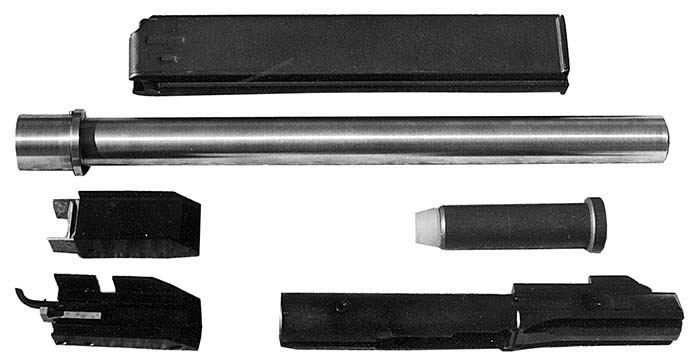
BARREL MODIFICATIONS
If you are using the SGW style system, you may be at a loss for a reasonably priced way to change the barrel. If you are using a Colt style system, it is a piece of cake to have custom barrels made up for varying conditions and requirements.
It is very convenient to use the aluminum or fiberglass “floating” handguard tubes as the only means of retaining the barrels. That means that the Colt style system permits quick change barrels without tools. This also makes it very easy to scrub out a barrel in the kitchen sink once you’ve slipped it out of the upper receiver.
UPPER RECEIVER MODIFICATIONS
The flat top uppers are ideal for competitive guns. They are tailor made for optical sights and permit a low mount that can be used without a cheek piece. Once again, this is more difficult with the SGW style conversion because their ejector is mounted in a cross pin in the upper receiver. Although SGW does not sell a conversion kit with the flat-top upper receiver, Dalphon does. If you are assembling a Colt style conversion from scratch; you can pick any type of upper receiver you want.
FRONT SIGHT MODIFICATIONS
With a custom barrel, it is easy to install one of the several after market front sight bases (gas blocks) that are offered for the M16 family. It could be retained with set screws and would enable the mounting of a front sight, to be used in conjunction with a detachable carrying handle for a back-up to an optical sighting system. It is no more difficult to install a custom gas block on the SGW 9mm upper than it is on any original M16. The removal of the front sight is still a nice option if any optical sight is used, even if mounted higher on the carrying handle, as it would have to be on an older conversion.

CONCLUSION
There are several distinct and different methods of completing a 9mm M16 conversion. Among these, you can go the SGW style route and minimize your expenses, go the Colt style route, or you can fully customize your conversion to optimize your own machine gun in a way you feel is best for you. Given the increases in the popularity of the 9mm/M16, and the unabated increases in the prices of other closed-bolt alternatives, there will probably be an increasing supply of the accessories available to customize an M16. The inherent difficulty in modifying the HK series weapons (beyond sticking additional gadgets on the outside of the gun), may permit the 9mm/M16 to gain the upper hand in true utility among the collector/shooters.
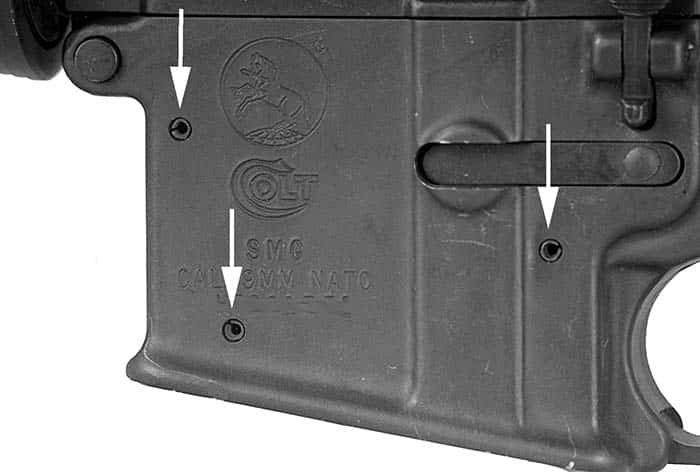
SOURCES
Colt Style Magazine Well Inserts with Bolt Catch Feature
JRW Sports, Inc.
E-mail: jrwsports@mindspring.com
3425 Yule Tree Drive
Ph: (904) 423-7805
Edgewater, FL 32141
Colt Style Conversion kits
C&S Metall-Werkes
Internet: www.csmetall-werkes.com
4025 Old Highway 94 S.
Ph: (314) 928-1511
Suite “O”
St. Charles, MO 63304
SGW Type Full-Auto Conversion Kits
Dalphon, Inc.
Internet: www.dalphon.com
P.O. Box 2215
Ph: (360) 427-6867
Shelton, WA 98584
SGW Semi-Auto Conversion Kits
Olympic Arms, Inc.
Internet: www.olyarms.com
620-626 Old Pacific Highway, SE Ph: (360) 459-7940
Olympia, WA 98513
Rate Reducers
Advanced Armament Corporation
221 West Crogan Street
Ph: (770) 277-4946
Lawrenceville, GA 30045
Various Original and After market Colt Style 9mm Conversion Parts:
J&T Surplus
Box 430
Ph:(606) 745-1757
Winchester, KY 40391
Custom M16 style components
ArmaLite, Inc.
P.O. Box 299
Ph. (309) 944-6939
Geneseo, IL 61254
| This article first appeared in Small Arms Review V2N1 (October 1998) |










